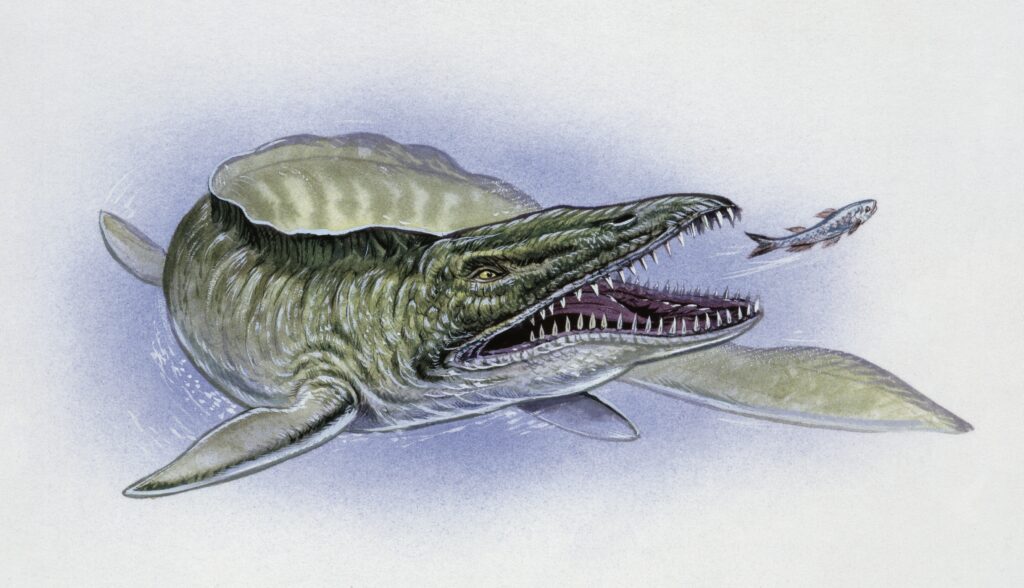Mosasaurs were some of the most fearsome apex predators to ever roam the oceans of the Cretaceous era. A recent discovery of a vertebrae fossil by Mississippi Department of Environmental Quality (MDEQ) geologist James Starnes reveals the presence of a gigantic mosasaur specimen.
Describing the find as “about as big as one could get,” Starnes told the local news outlet Hattiesburg American, “This [was] bigger than most dinosaurs walking around on land.”
Various mosasaur species inhabited Earth’s prehistoric waters up to 66 million years ago, but the fossil discovered on April 15 belonged to Mosasaurus hoffmanii, one of the largest species within the family.
Starnes explained, “This is a massive creature, with a potential weight of around 20,000 pounds.”
Although M. hoffmanii could have reached lengths exceeding 50 feet, Starnes and the MDEQ team estimate that the vertebrae came from a mosasaur that was likely around 30 feet long. Still an impressive size.
“Big enough to deter most individuals from entering the water if it existed today,” added Mississippi Museum of Natural Science paleontology curator George Phillips.
Fortunately, humans did not exist during the time of mosasaurs, with Homo sapiens only appearing around 300,000 years ago. As for the mosasaur’s prey, they were no match for the ocean-dwelling reptile.

While previous hypotheses suggested that mosasaurs moved like modern sea snakes, recent findings indicate that many of these predators had large, crescent-shaped tailfin flukes similar to sharks. This tail structure enabled mosasaurs to swiftly ambush their prey rather than engaging in long pursuits. Any unfortunate victims unable to escape were captured by the mosasaur’s 60 or so dagger-like teeth, including an additional set on the roof of their mouths.
Starnes and his team stumbled upon their latest discovery by chance. During fieldwork near Mississippi State University in Starkville to map local geological layers, geologist Jonathan Leard lost a collection of ancient seashells. While searching for the missing shells, Starnes noticed a partially exposed bone in the mud. It soon became evident that this discovery was far more significant than any seashell, although the thought of a mosasaur did not immediately come to mind.
“The size was so immense that we initially didn’t think it was a mosasaur,” Leard recalled. “This might be the largest specimen ever found in Mississippi.”
The Pride of Lions: A Closer Look at the Majestic King of the Jungle
Lions, the majestic and powerful creatures that roam the African savannah, are often referred to as the “King of the Jungle.” With their striking golden coats, impressive manes, and fierce roars, lions are truly a sight to behold. But there is much more to these iconic big cats than meets the eye.
Lions are social animals, living in groups called prides. A pride typically consists of several related females, their offspring, and a few adult males. The females do most of the hunting, working together to take down large prey such as zebras, wildebeests, and buffalo. The males, with their larger size and strength, are responsible for protecting the pride and its territory from rival males.
One of the most striking features of a male lion is its mane. The mane serves as a form of protection during fights with other males, as well as a display of dominance and attractiveness to potential mates. A lion’s roar can be heard up to five miles away and serves as a way to communicate with other members of the pride, as well as to warn off intruders.
Despite their reputation as fearsome predators, lions are actually quite vulnerable in the wild. Due to habitat loss, poaching, and conflict with humans, lion populations have declined significantly in recent years. Conservation efforts are underway to protect these magnificent creatures and ensure their survival for future generations.
In conclusion, lions are truly the pride of the animal kingdom. Their strength, beauty, and social structure make them a fascinating species to study and admire. As we work to protect these iconic creatures, let us remember the important role they play in maintaining the balance of the ecosystem and the beauty of the African savannah.


